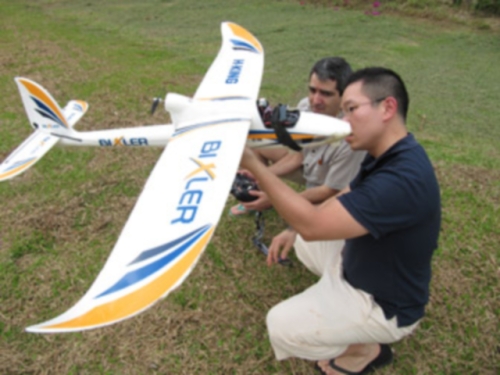Conservationists have converted a remote-controlled aircraft into a potent tool for conservation.
Using seed funding from the National Geographic Society, The Orangutan Conservancy, and the Denver Zoo, Lian Pin Koh, an ecologist at the ETH Zürich, and Serge Wich, a biologist at the University of Zürich and PanEco, have developed a conservation drone equipped with cameras, sensors and GPS. So far they have used the remote-controlled aircraft to map deforestation, count orangutans and other endangered species, and get a bird’s eye view of hard-to-access forest areas in North Sumatra, Indonesia.
“The main goal of this project is to develop low-cost Unmanned Aircraft Systems that every conservation biologist in the tropics can use for surveying forests and biodiversity,” said Koh via email. “UAS are already being used for many purposes including the military, agriculture, and even in Hollywood for filming. But they are still not commonly used for conservation purposes.”
The reason, says Koh, is the high cost of commercial systems, which can run $10,000-50,000. Koh’s first drone cost less than $2,000 and can be carried in a backpack.
“The UAS is almost fully autonomous, which means it can take-off and fly on autopilot,” Koh explained. “The user pre-programs each mission on a laptop computer by clicking waypoints along a planned flight path on a Google Map. Based on this flight path and the onboard sensors (GPS, altitude sensor, airspeed sensor, etc), the drone will take off automatically, fly to every waypoint, and then return to the user. During the mission, the drone can take photographs or videos depending on the camera system installed.”
For anyone who has spent hours tracking over rough terrain in the tropical rainforest, the appeal of a conservation drone is immediately obvious.
“This may offer a cost-effective way of counting wildlife over difficult terrain,” Stuart Pimm, an ecologist at Duke University who runs the conservation non-profit Saving Species, told mongabay.com. “Having imagery of far higher resolution than from satellites is essential for such work and it offers a viable alternative in places where helicopter or plane costs are too high.”
There are also scenarios where UAS can be an alternative to satellite imagery.
“Low-cost UAS can be an effective alternative to satellite images for mapping the landscape,” Koh said. “In fact, UAS can perform better than satellite data in cases where an area needs to be mapped in real-time and repeatedly.”
To date, Koh and Wich have used the UAS in Aras Napal, close to the Gunung Leuser Conservation Area in Sumatra. During their four days of testing, the drone flew 30 missions — collecting hundreds of photos and hours of video — without a single crash. A mission, which typically lasts about 25 minutes, can cover 50 hectares.
“The UAS took pictures of areas where logging occurred, and areas where oil palm are planted right next to a river, which is very damaging to the river ecosystem,” Koh said. “It also took pictures of an orangutan who was feeding on top of a palm tree, as well as elephants on the ground. During one mission, the drone also recorded a video showing smoke rising from a forest area. These test missions demonstrate that the UAScan indeed be used for the purposes it has been developed for.”
Koh envisions using the aircraft to monitor forests, detect fires, and map land use in real-time. He believes the low cost will open up the system to a wide range of other applications. “My dream is that in the future, every field ecologist will have a UAS as part of their tool-kit, since it doesn’t cost more than a good pair of binoculars!”
Koh says the response to the unmanned aircraft so far has been overwhelmingly positive from conservationists. “We have already attracted the attention of field researchers around the world, who are asking us to go to their study locations for further test flights. These locations include Borneo, Africa and even Antarctica to film penguins!”
Source:Mongabay.com

